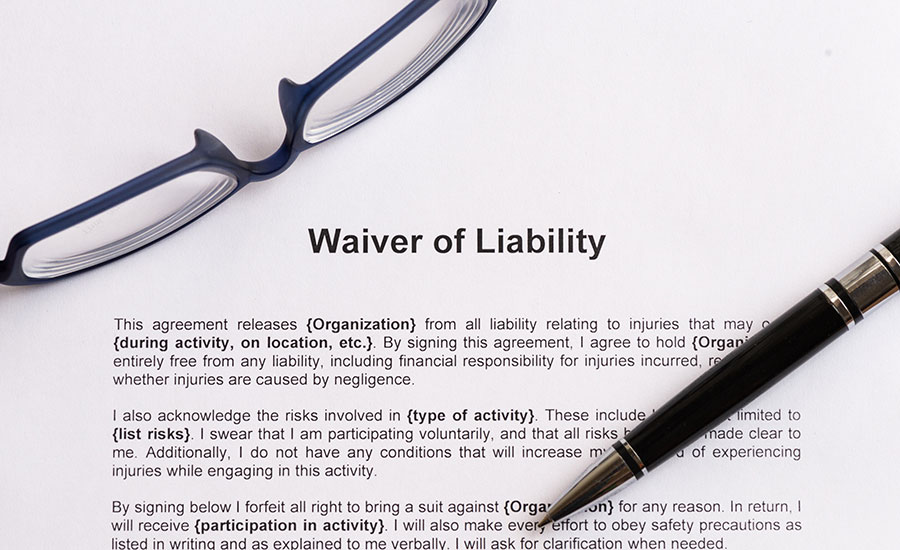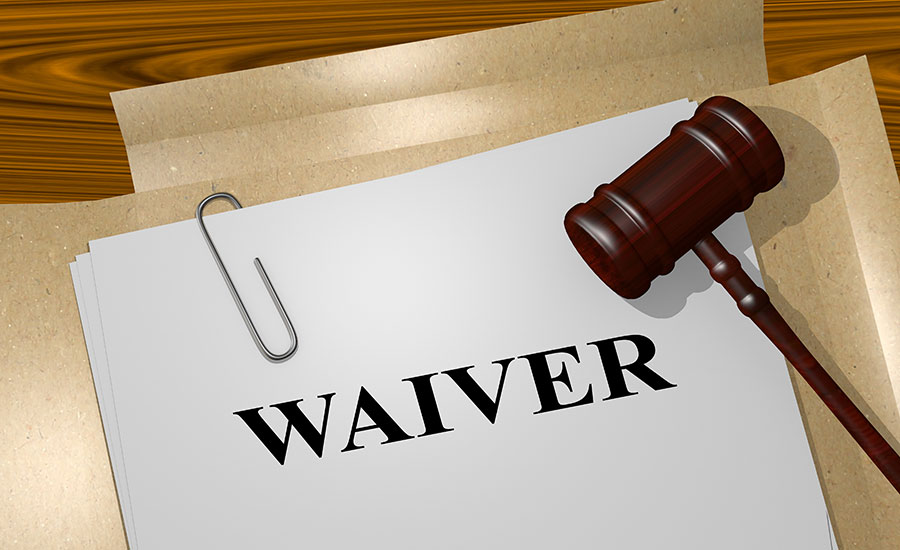
From healthcare providers to construction companies, waivers are an important tool for managing risk and protecting businesses from potential legal claims.
In this blog, we’ll explain the different types of waivers, provide examples of waivers and share how to write a waiver.
Plus, we’ll let you in on the secret to streamlining your waivers and other forms: going digital.
Table of Contents
Create a custom digital waiver.
Try doForms for free!
What Is A Waiver?
A waiver is a binding agreement between a customer and a company that serves to release the company from liability for certain actions or risks. If a customer refuses to sign a waiver, the company may refuse to provide services.
A waiver can be used to:
- Protect your business from potential lawsuits
- Inform your clients about the risks involved in a particular activity or service
- Establish responsibility, by making your clients aware that they are responsible for their actions and decisions, and that they understand the potential consequences
- Reduce insurance costs by ensuring that your clients acknowledge and accept the risks involved
- Meet legal requirements, if your company is required by law to have your clients sign a waiver to reduce liability
- Build trust with customers, by staying transparent about potential risks

A waiver can serve to protect your company against claims and lawsuits
Types Of Waivers
There are several different types of waivers, each serving a specific purpose for a business.
1. Release of liability waiver
A release of liability waiver or simply a liability waiver, is used to free a business from liability in the event of injury, harm or damage caused during the time your company provides a particular service.
This type of waiver is typically used in industries involving risks to health, property and finances.
For example, healthcare providers might use a liability waiver to protect themselves in situations where there is a high risk of injury or complications associated with a specific treatment or procedure.
A roofing contractor, on the other hand, might ask a property owner to sign a liability waiver to protect their business from claims arising from accidents or damage that may occur during the roofing work.
2. Waiver of subrogation
A waiver of subrogation is an agreement in which an insured party agrees to waive their right to seek compensation or damages from another party — typically a third party who may be responsible for damages or losses that the insured party experienced.
For example, a contractor hired for home renovation may require the client to sign a waiver of subrogation, so that in the event of damage, the client does not seek reimbursement from the contractor’s insurance company.
Waivers of subrogation are commonly used in construction, leases and other industries where multiple parties are involved and where risk allocation is needed.
3. Lien waiver
A lien waiver is typically signed by a contractor, subcontractor or supplier to waive their right to place a lien on a property or project, in exchange for payment for the work or materials provided.
It is a way to protect property owners and developers from potential liens and ensure that all parties involved in a construction project are paid in a timely manner.
4. Fee waiver
A fee waiver is an agreement that reduces fees for a service, either partially or fully. Fee waivers are commonly used by government agencies, educational institutions or non-profit organizations, either for clients who may be in a financially difficult situation or as an enticing mechanism to attract new clients.
For example, a bank might offer a fee waiver to attract new customers, by waiving fees associated with a loan application if the customer meets certain criteria, like a minimum credit score of 700.
Examples Of Waivers In The Healthcare Industry
The same industry may use different waiver forms in its daily operation. For example, the healthcare industry uses a variety of waivers to ensure protection against lawsuits, including:
- Waivers of informed consent: This type of waiver is used to obtain a patient’s informed consent for medical treatment, procedures or surgeries. It provides information about the risks and benefits of the treatment or procedure, as well as the potential complications or side effects.
- Health Insurance Portability and Accountability Act (HIPAA) waivers: HIPAA waivers allow healthcare providers to share a patient’s protected health information with other healthcare providers or third parties without obtaining the patient’s written consent. HIPAA waivers are typically used in emergency situations where obtaining consent is not possible or for research purposes.
- Waivers of refusal of treatment or care: Waivers of refusal of treatment or care are used when a patient refuses medical treatment recommended by healthcare providers. These waivers are typically used in situations where the patient’s decision may result in harm or injury.

From waivers of informed consent to HIPAA waivers, the healthcare industry uses several different types of waivers
How To Write A Waiver [What To Include]
So, where do you start? Here are the basic steps involved in writing a waiver of liability — one of the most widely used waivers across industries:
- Choose a template: Decide whether to use a paper template built with Microsoft Word, Microsoft Excel or Google Forms or a mobile form template like doForms that allows you to safely store, send and organize your waiver.
- Determine the type of activity or service: Identify the specific activity or service that the waiver will cover, along with the potential risks associated with it.
- State the purpose of the waiver: Include the purpose of the waiver, which is to release the provider from liability for any injuries or damages that may occur during the activity or service provided.
- Identify the risks: Determine the potential risks involved in the activity or service you are providing and explain that the participant assumes all mentioned risks.
- Include a title: Identify the type of waiver — in this case, a liability waiver.
- Include customer information: List the name and contact details of your customer or client.
- Include waiver terms: Provide a clear statement of what your customer is waiving, a description of the risks involved and a section that releases your business from liability.
- Include a statement of understanding: Add a section stating that the participant has read and understands the terms of the waiver, and that they voluntarily agree to the terms.
- Include space for customer signature and date of signing: Adding a date and signature will serve as proof that your customer read and agreed to the waiver terms.
Make sure your waiver is easy to read by using headings, bullet points and paragraphs.
Use clear and concise language that your customers can easily read and comprehend.
Factors To Consider When Writing A Waiver
- The legal requirements in your state: Take into account the laws in your state that are applicable to your industry and waiver process.
- The standards in your industry: Familiarize yourself with the waivers used within your industry to make sure you cover all risks and comply with the best practices.
- Legal advice: Consider speaking to an experienced attorney to make sure your waiver will adequately protect your business.
- Storage: Once waivers are signed, make sure to store them securely in a place where they can be easily accessed if needed. Note that digital waivers offer added security and organization.
- Informed participation: Give your customers enough time to read and understand the waiver before signing it.
How To Write A Waiver With doForms
doForms is a mobile forms solution designed for collecting data, managing workflows and creating reports, allowing you to keep all of your documents in one secure, centralized location.
From contractors and service providers to in-home health care providers, our digital solutions at doForms help businesses across industries go paperless to save money and get organized.
With doForms, you can create, update, store and send waivers, reports and other digital forms, utilizing a user-friendly dashboard with 30+ drag-and-drop capabilities.
Explore our library of easy-to-use mobile forms or build your own customized digital waivers in minutes.
You can edit your waivers with a single click on any device, gather electronic signatures and store your documents electronically in a secure location, eliminating the need for messy and costly paperwork.
doForms also offers robust reporting and analytics features, where you can track waiver completion rates, identify trends and improve workflow across your organization.
Build a custom waiver with doForms.
Start your free trial!
Key Takeaways On How To Write A Waiver
Serving as an agreement between a customer and a company, a waiver is used to protect a business against potential legal actions.
While the most common type of waiver is a waiver of liability, there are many other types, including lien waivers, fee waivers and waivers of subrogation.
To build a waiver of liability:
- Choose a waiver template
- Determine the type of activity or service
- State the purpose of the waiver
- Identify the risks
- Include a title
- Include customer information
- Include waiver terms
- Include a statement of understanding
- Include space for customer signature and date of signing
Before creating your liability waiver:
- Research the legal requirements in your state
- Research the standards in your industry
- Consult a lawyer
- Consider digital forms for secure storage
- Ensure informed participation
A cutting-edge mobile forms solution, doForms allows you to build, send and save digital waivers from any location or device.
Start building your custom waivers and forms today with a free trial at doForms!




